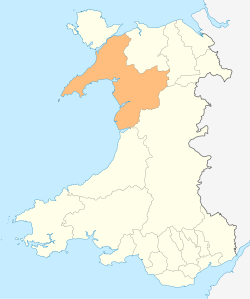This article needs additional citations for verification .(January 2016) |
| Ganllwyd | |
|---|---|
 Stone house and chapel in Ganllwyd | |
Location within Gwynedd | |
| Population | 179 (2011) |
| OS grid reference | SH726244 |
| Community |
|
| Principal area | |
| Country | Wales |
| Sovereign state | United Kingdom |
| Post town | DOLGELLAU |
| Postcode district | LL40 |
| Dialling code | 01341 |
| Police | North Wales |
| Fire | North Wales |
| Ambulance | Welsh |
| UK Parliament | |
| Senedd Cymru – Welsh Parliament | |
Ganllwyd is a small village and community in southern Gwynedd, Wales. It lies in the Snowdonia National Park to the north of Dolgellau. A470 passes through it. The Community population taken at the 2011 Census was 179. [1]


